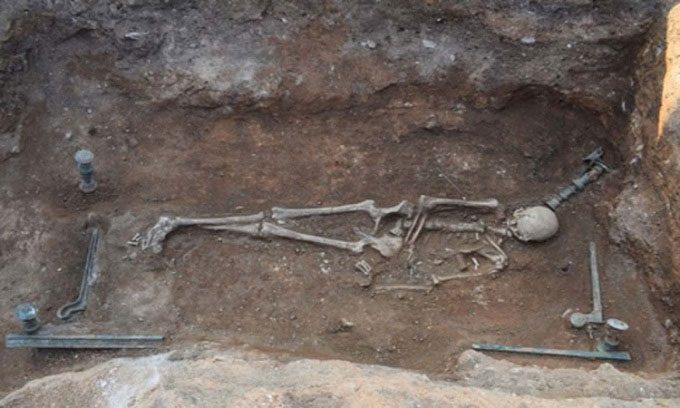An Ancient Woman Buried with Lavish Adornments and a Gold Leaf in Her Mouth May Have Been Royalty.
Archaeologists discovered the tomb of this woman in 2019 in the village of Mavropigi in the Kozani region of northern Greece. What surprised them was that the tomb remained intact at a depth of 1.5 meters beneath the surface of a previously destroyed house. The archaeological team determined that the woman died at the end of the Hellenistic period (around the end of the 1st century BC).

The skeleton found in the intact tomb from the late 1st century BC. (Photo: Kozani Ephorate of Antiquities)
According to e-ptolemeos.gr, the tomb of the woman contained numerous burial items including five clay jars that may have held perfumes, a glass object, and other small artifacts. The woman wore a decorative headband made of fabric and gold, and she held a piece of fabric decorated with golden threads. A gold leaf-shaped object was placed inside the deceased’s mouth.
Areti Chondrogianni-Metoki, director of the Kozani Ephorate of Antiquities, stated that there are indications suggesting the woman was very wealthy or held a high status in society at that time.
What excites archaeologists the most is the bronze bed on which the woman’s remains were placed, oriented north-south. Above the bed frame is decorated with symbols of the Greek god Apollo. The foot of the bed features a mermaid’s head. The significance of this bronze bed prompted the research team to meticulously reconstruct and create a miniature version in 2020. To complete this task, they had to fill in the voids left by the wooden parts of the bed, which had decayed after a long time underground.
The use of burial goods aligns with the customs of the period in which the woman lived. The remains of the woman have been transferred to the Aiani Archaeological Museum for further study. According to Greek Reporter, analysis results indicate that the woman died in middle age and may have descended from royalty or held a significant religious position in society. The museum’s laboratory will attempt to confirm the woman’s age, gender, and cause of death.


















































